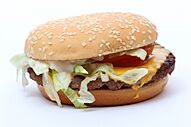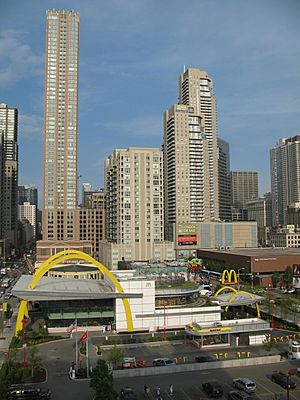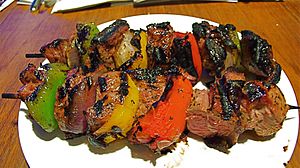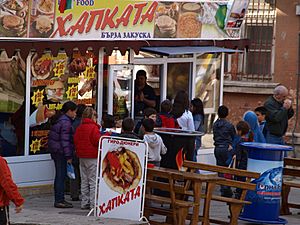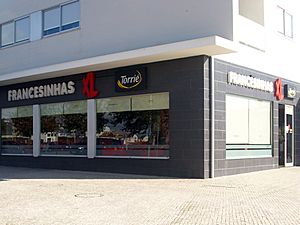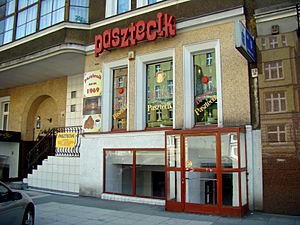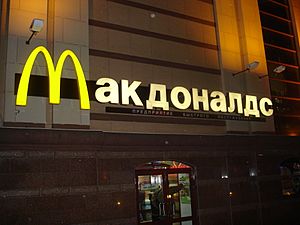Fast food facts for kids
Fast food is food that is made and served very quickly. It's often prepared in large amounts using machines. The main goal is to get your food to you super fast! This type of food is usually sold in restaurants or stores. The ingredients are often frozen, preheated, or already cooked. You usually get your meal in special packaging so you can easily take-out or take it away.
Fast food became popular because many people are busy. Think of commuters, travelers, or people working long hours. They need a quick meal. In 2018, the fast food industry was worth about $570 billion around the world. That's a lot of burgers and fries!
Some fast food is pre-cooked, so you get it in seconds. Other places, like McDonald's or Burger King, use ingredients that are already prepared. For example, buns come in bags, and vegetables are pre-washed. They cook the meat and french fries fresh. Then, they quickly put your order together.
Fast food restaurants often have a drive-through. This lets you order and pick up food without leaving your car. Some places are small stands or kiosks with no seats. Others are bigger restaurants with indoor seating. Many fast food places are part of large chains. This means their food is the same in every location.
While fast food is convenient, it can sometimes be high in saturated fat, sugar, salt, and calories. Eating a lot of fast food has been linked to health issues. These can include obesity, high cholesterol, and other problems. It's important to have a balanced diet.
Contents
The Story of Fast Food
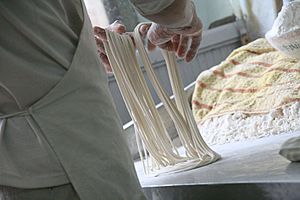
The idea of buying ready-cooked food is very old. It grew as cities grew. In old cities, many homes didn't have much space to cook. Cooking fuel could also be expensive. Frying food with hot oil was dangerous. People worried about fires spreading through neighborhoods. So, city dwellers often bought pre-made meals. This included cooked meats, bread, or noodles. This was also great for busy people. They didn't have to wait long for their food.
In Ancient Rome, cities had street stands. These were counters where food and drinks were served. Romans could buy baked goods and cured meats. In the mornings, they ate bread soaked in wine as a quick snack. Later, they could get cooked vegetables and stews at a popina. This was a simple place to eat.
In Asia, people in 12th-century China ate fried dough, soups, and stuffed buns. These are still popular snacks today. In Baghdad, people bought processed beans, starches, and even ready-to-eat meats. During the Middle Ages, big cities like London and Paris had many vendors. They sold pies, pasties, waffles, and cooked meats. Many of these places served people who couldn't cook at home. This included single people or those without kitchens. Travelers, like pilgrims, also bought food from them.
Fast Food in the United Kingdom
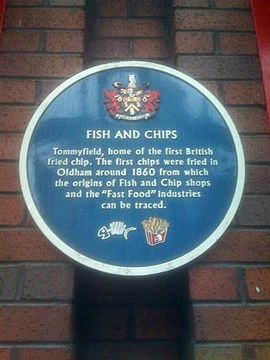
In areas near the coast, 'fast food' often meant local shellfish or seafood. This included oysters or eels in London. This seafood was often cooked right on the dock. In the mid-1800s, trawler fishing became popular. This led to a British favorite: fish and chips. The first fish and chip shop opened in 1860.
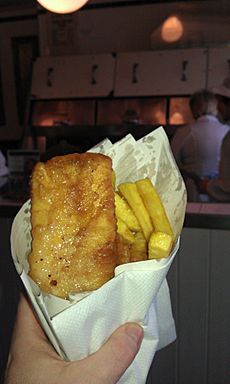
A special blue plaque in Oldham, England, shows where fish and chips began. This cheap fast food, served in a wrapper, became a common meal for the Victorian working classes. During the Industrial Revolution, fish and chip shops grew fast in Britain. They met the needs of the growing factory population. By 1910, there were over 25,000 fish and chip shops in the UK. In the 1920s, there were more than 35,000! The Harry Ramsden's fast food chain opened its first fish and chip shop in Guiseley in 1928. In one day in 1952, this shop served 10,000 portions of fish and chips. This earned it a spot in the Guinness Book of Records.
British fast food also had local differences. For example, the Cornish pasty is famous in Cornwall. The UK has also adopted fast food from other cultures. This includes pizza, doner kebab, and curry. Lately, healthier fast food options have also appeared.
Fast Food in the United States
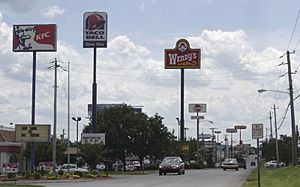
After World War I, cars became very popular and cheaper. This led to the creation of drive-in restaurants. The American company White Castle is often seen as the first fast food chain. It was started by Billy Ingram and Walter Anderson in Wichita, Kansas, in 1921. They sold hamburgers for just five cents each. Walter Anderson had opened the first White Castle restaurant in 1916. He created the idea of a small menu, lots of sales, low prices, and fast service. One new idea was letting customers watch their food being made. White Castle was very successful and many other companies copied their idea.
The idea of franchising started in 1921 with A&W Root Beer. They let others sell their special syrup. Later, Howard Johnson's was one of the first to franchise a whole restaurant idea in the 1930s. They made sure all their restaurants had the same menus, signage, and ads.
"Curb service" started in the late 1920s. This is where staff brought food to your car. In the 1940s, carhops on roller skates made it even faster!
The United States has the biggest fast food industry in the world. American fast food restaurants are in over 100 countries. About 5.4 million people in the U.S. work in food preparation and service, including fast food. Some people worry about obesity and health problems. This has led some local governments to think about limiting fast food restaurants. Even with rising costs, many adults in the U.S. still eat fast food. This shows that people really like it. In some areas, like South Central Los Angeles, about 45% of restaurants are fast food chains. On the Westside, it's only about 16%.
Working in Fast Food
A study from the University of California, Berkeley in 2013 looked at fast food workers. It found that over half (52%) of these workers needed help from public programs. These programs help them afford things like health care and food. This means that the low wages and few benefits in the fast food industry cost taxpayers about $7 billion each year.
Fast Food on the Go
Fast food places are made for quick service. Many have a "drive-through" so you can get food from your car. Others have places to sit inside or outside. Today, you can even order fast food from your phone using apps!
From the very beginning, fast food was made to be eaten "on the go." You often don't need forks or knives. You can just eat it with your hands. Popular fast food items include fish and chips, sandwiches, hamburgers, fried chicken, french fries, tacos, pizza, and hot dogs. Some places also offer "slower" foods like chili or salads.
Gas Station Food
Many gas stations have Convenience stores. These stores sell pre-packaged sandwiches, doughnuts, and hot food. In some places, gas stations also sell frozen foods. They might even have microwave ovens for you to heat them up. Gas stations are often open for long hours. This makes it easy for people to grab food while traveling.
Street Food Vendors
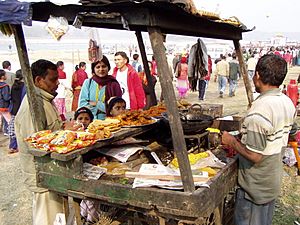
You can find traditional street food all over the world. Small vendors often sell it from carts, tables, or food trucks. Some examples are Vietnamese rice soup, Middle Eastern falafel, or hot dog carts in New York City. Street vendors often have colorful displays to get your attention quickly.
Many street vendors specialize in certain types of food. This food often shows the culture of that area. In some cultures, vendors might call out prices, sing, or play music. This "street theatrics" can sometimes get more attention than the food itself!
Types of Fast Food
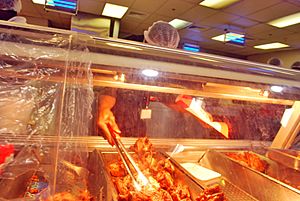
Modern fast food is often "ultra-processed food". This means it's made in a factory on a large scale. They use standard ingredients and cooking methods. It's usually served quickly in cartons or bags to keep costs low. Most fast food items are made from ingredients prepared at a central factory. Then, they are sent to each restaurant. There, they are reheated, cooked (like by deep frying), or put together fast. This makes sure the food tastes the same every time. It also helps deliver orders quickly and saves money on labor.
Because fast food focuses on speed, sameness, and low cost, the ingredients are often made to have a certain flavor or texture. They are also made to stay fresh for a while.
Different Fast Food Styles

Chinese takeaway restaurants are very popular in Western countries. They usually offer many kinds of Asian food, often fried. Most options include noodles, rice, or meat. Sometimes, the food is set up like a buffet. You choose the size of your container and fill it with your favorite foods. You can mix different options. Some places charge by weight. In big cities, these restaurants might even deliver for free if you spend enough.
Sushi has become very popular in the Western world. It's a type of fast food from Japan. Bentō is another Japanese fast food. Sushi is usually cold sticky rice with a sweet rice vinegar flavor. It's served with a topping, often fish. The most popular kind in the West is rolled in nori (dried green laver) with a filling. Fillings often include fish, seafood, chicken, or cucumber.
Pizza is a very common fast food in the United States. Big chains include Papa John's, Domino's Pizza, and Pizza Hut. Pizza is a major source of fast food calories for children. These chains have simpler menus than traditional pizzerias. They also offer pizza delivery.
Kebab houses are fast food restaurants from the Middle East. They are especially popular in Turkey and Lebanon. Meat is sliced from a large spinning rotisserie. It's served on warm flatbread with salad and sauce. These are called doner kebabs or shawarmas. They are different from shish kebabs, which are served on sticks. Kebab shops are found around the world, especially in Europe, New Zealand, and Australia.
Fish and chip shops are very popular in the United Kingdom, Australia, and New Zealand. Fish is dipped in batter and then deep fried. It's served with deep-fried potato strips.
The Dutch have their own fast food. A Dutch fast food meal often has french fries (called friet or patat) with a sauce and a meat product. The most common sauce for fries is fritessaus. It's a sweet, vinegary, low-fat mayonnaise substitute. Other popular sauces are ketchup or spicy ketchup ("curry"). There's also Indonesian-style peanut sauce ("satésaus"). Sometimes, fries come with combinations of sauces. For example, speciaal has mayonnaise, ketchup, and chopped onions. Oorlog (meaning "war") has mayonnaise and peanut sauce. The meat product is usually a deep-fried snack. This includes the frikandel (a deep-fried sausage) and the kroket (deep-fried meat ragout covered in breadcrumbs).
In Portugal, there are local fast food options. Some popular foods include frango assado (Piri-piri grilled chicken), francesinha, and bifanas (pork sandwiches). These are often served with french fries. Some international chains have even started selling Portuguese fast food, like Nando's.
In Poland, a local fast food is pasztecik szczeciński. It's a deep-fried dough filled with meat or vegetables. It's a famous dish from the city of Szczecin. The first place to sell it, Bar "Pasztecik," opened in 1969.
In East Asia, noodle shops are very common. Flatbread and falafel are popular in the Middle East. In India, popular fast food dishes include vada pav and panipuri. In West Africa, roadside stands sell grilled meat sticks called brochettes.
The Fast Food Business
In the United States, people spent $160 billion on fast food in 2012. This was a big jump from $6 billion in 1970. In 2013, the total sales for U.S. restaurants were $660.5 billion. Fast food has been facing competition from "fast casual" restaurants. These places offer more unique and sometimes more expensive food. Because of this, some big fast food chains have seen their sales drop.
Americans spend less of their money on food compared to other countries. This is partly because the government helps make fast food cheap. Foods sold in fast food restaurants often cost less and have more calories. They are mostly made from products that the government helps pay for, like corn, soy, and beef.
The fast food market in Australia is worth over 2.7 billion GPB. People eat 1.4 billion fast food meals there each year. There are 17,000 fast food places in Australia. This market has grown by 6.5% each year, making it the fastest-growing part of the food market.
Fast Food Advertising
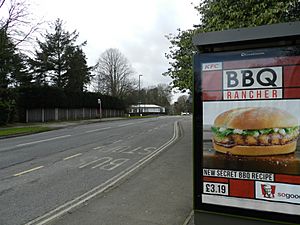
In 2012, fast food restaurants spent about $4.6 billion on ads. This was an 8% increase from 2009. During that time, McDonald's spent almost three times more on ads than all water, milk, and produce advertisers combined.
A study from Dartmouth College found something interesting. When children watch more TV commercials for fast food, they are more likely to ask to go to those restaurants. Fast food places have been increasing their ads for Black and Hispanic youth. A 2021 report found that fast food restaurants spent about $318 million on Spanish-language TV ads. They spent about $99 million on TV channels watched mostly by Black viewers. Black youth saw more fast food ads than white youth.
In 2006, the Council of Better Business Bureaus started an initiative. They asked fast food companies to promise to "advertise only more healthful products to children." McDonald's and Burger King signed up. But studies show this initiative might not be working well. Children couldn't remember healthy foods in the ads. In one study, 81% of young children remembered french fries, even if they weren't in the ad!
Working in Fast Food
According to the U.S. Bureau of Labor Statistics, about 4.1 million people in the U.S. worked in food preparation and serving (including fast food) in 2010. They expect average job growth in this area. There are often many job openings because people change jobs a lot. For example, in April 2011, McDonald's hired about 62,000 new workers. They received a million applications for those jobs! That means only about 6.2% of people who applied got a job. In 2013, the average age of workers in this industry was 28.
Getting a diploma in Human Resource Management or Fast Food Management can help you get a job in big fast food restaurants.
Fast Food Around the World
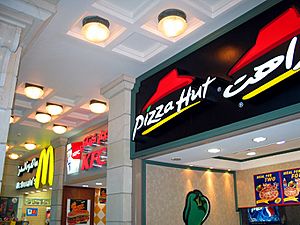
In 2006, the global fast food market grew by 4.8%. It reached a value of £102.4 billion. McDonald's alone has restaurants in 126 countries. They operate over 31,000 restaurants worldwide.
One example of McDonald's growing globally is when it came to Russia. For the American business to succeed, it needed to fit into the daily lives of people in Moscow. So, McDonald's made sure its food matched the eating habits of Muscovites. Russians like to know where their food comes from. So, McDonald's promoted that their ingredients were local. On January 31, 1990, McDonald's opened a restaurant in Moscow. It broke records for how many customers it served on opening day. The Moscow restaurant is one of the busiest in the world.
There are many other fast food restaurants all over the world. Burger King has over 11,100 restaurants in more than 65 countries. KFC is in 25 countries. Subway is one of the fastest-growing chains. It had about 39,129 restaurants in 90 countries by May 2009. The first Subway outside the U.S. opened in Bahrain in 1984. Pizza Hut is in 97 countries. Taco Bell has 278 restaurants in 14 countries outside the United States.
Images for kids
-
A delicious Cheeseburger.
-
A refreshing soft drink.
-
Crispy french fries.
-
A slice of pizza Margherita.
-
A classic hot dog.
-
Golden fried chicken.
-
A tasty submarine sandwich.
-
Sweet donuts.
See also
 In Spanish: Comida rápida para niños
In Spanish: Comida rápida para niños
- Fast food in China
- Fast Food Song
- Food group
- Junk food
- List of fast food restaurant chains
- List of pizza chains
- List of restaurant terminology
- Lists of foods
- National Center for Health Statistics
- Panic Nation
- Slow Food
- Snack
- Super Size Me
- TV dinner
- Western pattern diet


